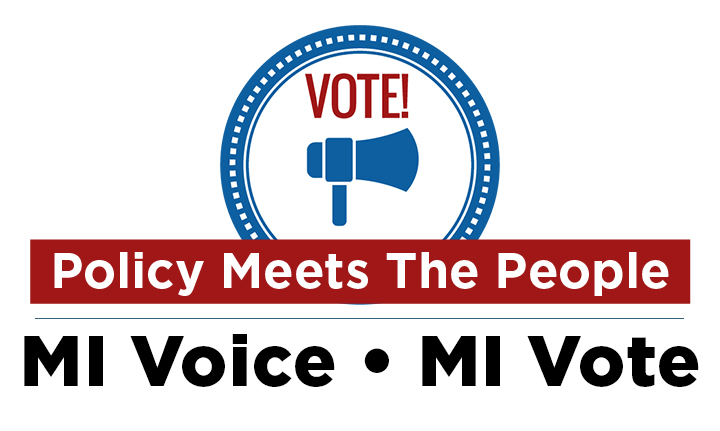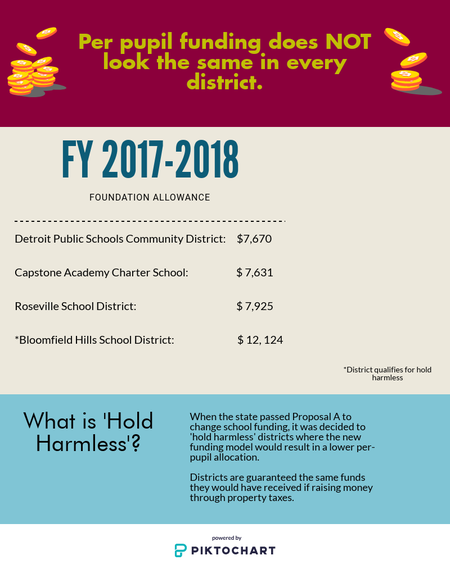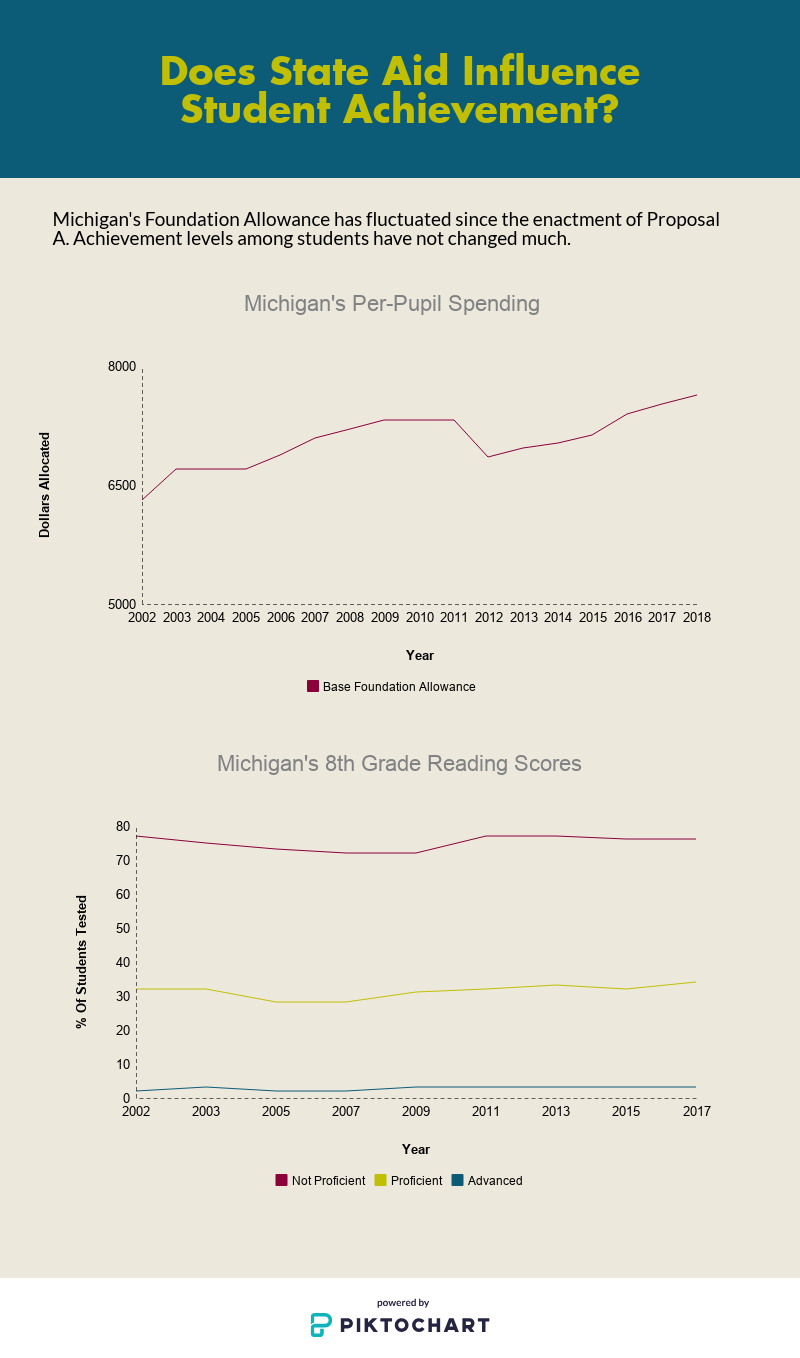How are Michigan’s Public Schools Funded?
Some experts are blaming the state’s formula for funding education for Michigan’s poor achievement scores.

The National Assessment of Educational Progress’ “report card” showed that less than 40 percent of Michigan’s students are proficient in reading and math. Some experts are blaming the state’s formula for funding education. As part of the series ‘Policy Meets the People: MI Voice MI Vote’, WDET takes a look at how Michigan’s public schools are funded and whether changes in funding might lead to improvements in achievement.
What is per-pupil funding?

The Foundation Allowance
In 1993, Michigan’s legislature devised a plan to help close the gap between wealthy and poor school districts.
Before Proposal A, schools were primarily funded through property taxes, with some money coming from the state. Prop A created the foundation allowance, which guaranteed schools a certain amount of money per student, subsidized by the school aid fund.
Mike Addonizio is a professor of education policy studies at Wayne State University.
“It substantially increased per-pupil funding for the lower revenue school districts,” Addonizio says. “And it also slowed down the growth in revenue in the property-rich school districts.”
Addonizio says the goal of Prop A was to reduce the reliance on local property tax to support school operations and shift to a greater share of state revenue.
School districts were still allowed to levy property taxes on communities to help fund schools, but only up to 18 mills on the taxable value of the property.
The foundation allowance allocates money on a sliding scale between $7,631 and $8,289.
Because of this, all school districts are not funded equally.
Support the news you love.
Here at WDET, we strive to make our journalism accessible to everyone. As a non-profit public media institution, we maintain our journalistic integrity through independent support from readers like you. Because you value WDET as your source of news, music, and conversation, please make a gift of support today. Even $5 a month helps!
Hold Harmless Districts
When Prop A was enacted, legislatures wanted to make sure that school districts would not receive less in state aid than they would have raised in property taxes for school.
When the state passed Proposal A to change school funding, they decided to ‘hold harmless’ districts where the new funding model would lower the per-pupil allocation.
Those districts were allowed to levy an additional tax to make up the difference.
All districts can also apply for categorical grants. But those dollars can only be spent on programs identified in the grant.
Schools still underfunded
The School Finance Research Collaborative conducted a study that examined Michigan’s foundation allowance. They asked nearly 300 Michigan educators what school should look like, and how much would it cost to get there. The study suggested the foundation allowance should be increased to $9,590 per student.
Randy Liepa is the Superintendent of Wayne RESA, the intermediate school district for Wayne County. He is a member of the collaborative. He said school funding should be linked to the actual students being served.
“As opposed to looking at where the school system is located or how much other school districts spend,” said Liepa.
Liepa said an increase in the foundation allowance would allow schools to lower classroom sizes and allow more time for teacher training — which could lead to improved student achievement.
“It costs more to educate students in poverty,” said Dania Bazzi, superintendent of Ferndale Schools. “It costs more money to educate special education students. It costs more money to educate English language learners. And yet, our per-pupil allocation is not reflective of that.”
Bazzi said the district has about 3,000 students and 60 percent live in poverty. She said stretching those dollars is very difficult and raising the foundation allowance to $9,590 per student would increase the district’s budget by $4.4 million. That is significant.
Governor Rick Snyder is proposing an increase to the per-pupil allowance in next year’s budget that gives schools between $120 and $240 more per student. It’s the largest increase in nearly 15 years.
How is the money spent?

But Ben DeGrow, the Director of Education Policy at the Mackinac Policy Center said there is no relationship between dollars spent and achievement levels.
In fact, a study it conducted showed a ten percent increase in funding would improve achievement by less than half of a percent.
It’s how schools spend that money that’s the problem, DeGrow said. He said schools are not spending money on things that improve achievement.
About 80 percent of the foundation allowance schools get every year goes to operational costs, like administration, teachers and cafeteria services.
That leaves only 20 percent of the allowance to purchase things like books, software, and other instructional materials.
Some districts can ask voters to increase taxes to get more money in school budgets, but that usually doesn’t go to classrooms, either. It tends to go toward maintaining buildings.
DeGrow argues the solution to higher achievement is deciding how to properly allocate the current allowance.
“We spend a significant amount of dollars on giving extra teacher salaries for earning a master’s degree,” DeGrow said. “Even though research strongly shows that these degrees on average don’t help students learn.”
Bill Good is the director of Communications for Ferndale Schools. He says the consequences of getting school funding wrong are clear.
“It’s a pretty large criticism of our school system when a giant corporation like Amazon won’t even consider coming here because of the talent gap of the area,” Good said.
There is no argument that Michigan schools are failing. According to the National Assessment of Educational Progress’ annual report card, more than half of students tested in the state are not proficient in reading and math at elementary, middle and high school levels.
Whether better achievement is a product of better funding or of better allocation of funds, this debate continues as Michigan maintains its ranking as one of the worst education states in the country.
